Five-Year Assessment
The overall vision of Landscapes3 is: "In 2045, Chester County abounds with healthy natural areas, robust farms, cherished historic sites, diverse housing, thriving businesses, quality education, accessible transportation, and vibrant communities for all."
How have we done with this Vision over the past five years? Overall, pretty good, despite the pandemic and its many impacts that are still reverberating throughout our society and economy. We have continued preserving significant open space, modernizing our agricultural industry, preserving historic sites, building more apartments and townhouses, expanding our businesses, upgrading our educational infrastructure, adding trails and sidewalks, and improving our local communities.
Not everything has been perfect, but, in the face of tremendous international and national crises and ongoing development pressure, Chester County has balanced its growth and preservation fairly well.
To assess how we have done, the planning commission analyzed the implementation of the 57 Landscapes3 recommendations, measured on-the-ground change with a variety of metrics, and identified where development occurred in relation to growth and rural resource areas.
Implementation Overview
The 57 recommendations in Landscapes3 provide specific guidance on how the county, the planning commission, and all of our partners can make progress on the vision, goals, and objectives. Progress has been made on every recommendation, with significant or very significant progress on 52 of the 57 recommendations. It is clear that everyone has been working hard to implement the county's plan.
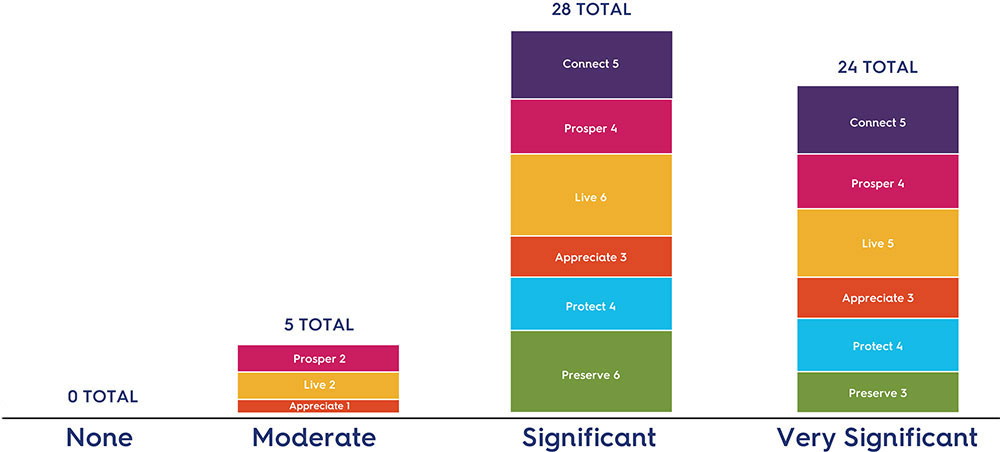
Progress has been made on every recommendation, with significant or very significant progress on 52 of the 57 recommendations.
In particular, there has been substantial progress on plan preparation that has provided guidance on specific topics, while identifying additional work to be done. These plans include a new climate action plan, an agricultural economic development plan, a watersheds plan, a heritage tourism plan, a freight plan, a draft trails plan, and a draft public transportation plan.
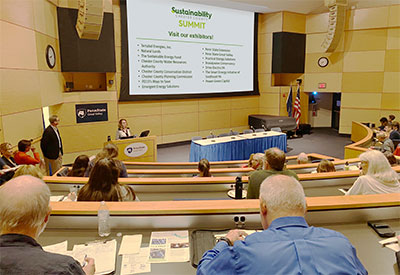
Chester County held its first-ever Sustainability Summit on September 26, 2023.
In addition, there was substantial progress on outreach and education, including the hosting of many events and summits, the production of a wide range of educational guides, and the sharing of tailored recommendations to municipalities on key planning topics. These topics focused on open space preservation, appropriate solar ordinances, natural resource protection, housing affordability, expanded mobility options, complete streets, ag-friendly communities, and historic village preservation.
Landscapes3 wasn't just implemented with the production of topic-specific plans or the dissemination of new educational materials. It was also implemented on the ground by every organization involved in some way with the built and natural environments in Chester County. Substantial progress was made on preserving farmland, expanding recreational opportunities, potentially expanding passenger rail service, and expanding the regional trail network.
There were a few recommendations that saw limited implementation over the past five years that should be reexamined over the final five years of the plan. These include fostering of historic preservation funding programs, promoting universal design, supporting emergency service providers, ensuring economic development planning is up-to-date, and encouraging suburban center investment.
Measuring Progress
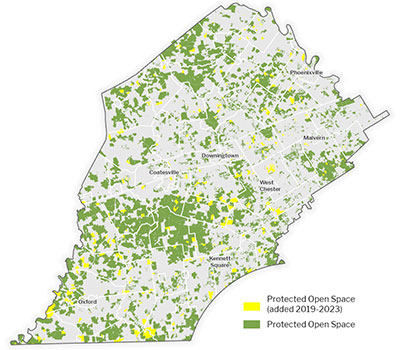
Preserve Goal Metrics
The Preserve Goal is focused on open space preservation, and the county has made excellent progress on this goal, with the amount of preserved open space in the county rising from 28.8% of the county's land area to 31.1%, which shows nearly half a percent being preserved each year. Although the amount of land being preserved each year is not as great as in prior decades, there is slow steady progress on preservation despite increasing competition for land.
Farmland preservation is the largest element of open space preservation nowadays, with over half of the county's farmland now permanently protected.
Another key element of open space preservation is its connectivity, which is critical for environmental, scenic, and trail purposes. Over the past five years, the county's open space has become more connected, with over 42% of the county's conservation corridor land area now permanently preserved.
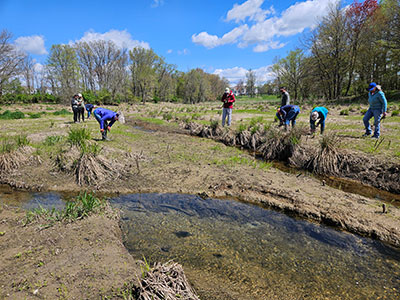
Photo credit: Craig Thomas, CCWRA
Protect Goal Metrics
The protect goal is focused on the protection of natural resources. With new development across the county and over 5,000 acres of greenfield development during the past five years, there most likely has been a negative impact on the county's natural resources, although, nowadays, new development often protects some of these resources. On the other hand, ongoing open space preservation has permanently protected many natural resource areas.
During the past five years, many municipalities have strengthened their natural resource protection ordinances, and the number of effective natural resource protection standards has increased from 203 to 212.
Our stream's health has essentially stayed the same, bouncing around from year to year, often depending on the severity of local storms.
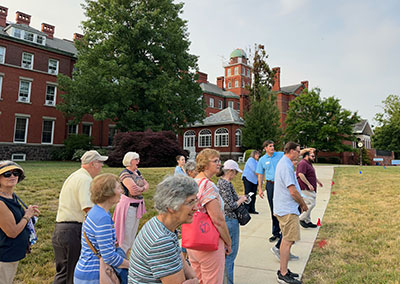
Appreciate Goal Metrics
The appreciate goal is focused on historic preservation, which, with the nation's upcoming 250th commemoration, has drawn renewed attention. There is a new America250PA Chester County committee working on this anniversary, and the county adopted a Heritage Tourism Plan in early 2024.
Over the past five years, many municipalities have strengthened their heritage protection measures, with the number of adopted measures increasing from 142 to 158.
With the pandemic, historic tourism has been all over the place, with significant drops at one point, followed by a surge in attendance, leading to a 35% increase from 2019 through 2023.
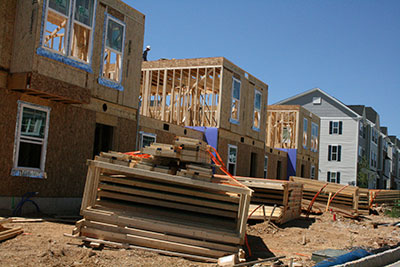
Live Goal Metrics
The live goal focuses on local communities, with an emphasis on housing. Generally, the county's communities have continued to strengthen their sense of place, provision of community facilities, and housing choices.
The housing picture is truly a mixed bag. On the one hand, the county's housing stock has become more diverse, reflecting changing lifestyles and household composition. From 2019 through 2023, 36% of the residential units built were apartments, 32% were attached homes, and 32% were single-family detached homes. In 2018, according to the US Census, 60% of the county’s homes were single-family detached; so, the new housing construction is making the county's overall housing stock more diverse.
During these years, hundreds of affordable housing units were built, which is helpful but does not compensate for the huge run-up in housing costs from 2019 to 2023. In fact, the median sales price of homes sold in Chester County rose from $355,000 in 2019 to $492,000 in 2023, an astounding 39% increase over 5 years. Housing, which was already expensive, has gotten extremely expensive.
Looking at other elements of the Live Goal, there were a lot of improvements to local community facilities, with many new and improved schools, municipal buildings, and parks. The share of the county’s population within a half mile of a park rose from 70% to 78%.
For solid waste, there was a slight decline in per capita waste generation.
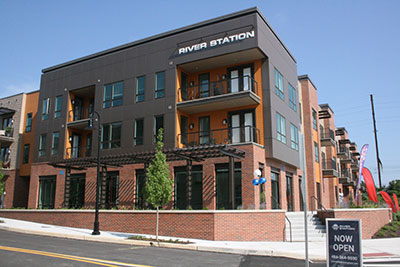
Prosper Goal Metrics
The prosper goal focuses on economic development, which the pandemic drastically affected in 2020. Overall, the county's economy has been resilient, which is partially due to its diversity and underlying strength. In addition, the county's urban centers have continued to revitalize, with Phoenixville experiencing tremendous growth and Coatesville seeing significant new investment.
New nonresidential construction has been moderate, with a little over a million square feet built per year. Institutional construction has constituted the largest share of this construction. With the pandemic and work from home, office construction has dried up, while industrial construction has increased compared to prior years.
Investment in urban centers has been strong, which is reflected in the change in assessed value. In the county's sixteen urban centers, the assessed value of all properties increased 2.8% from 2019 through 2023 while the county as a whole only increased 0.9%.
Workforce development became a real challenge during the pandemic, and major changes were made to the County programs that assisted and provided training opportunities to those in need of work. These redesigns took time and have recently begun making progress.
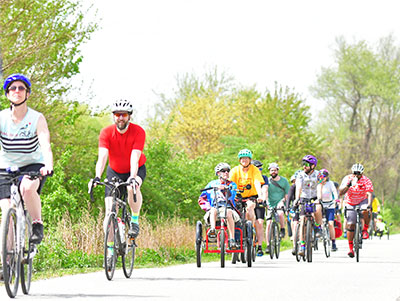
Connect Goal Metrics
The connect goal focuses on transportation and infrastructure, and a strong base is being laid for future transportation improvements because of federal infrastructure legislation. With the shift to remote work, the transportation picture is mixed.
Public transportation ridership is down significantly, reflecting national and regional trends. On the other hand, vehicle driving times are also down, making the drive to work faster for most people.
The active transportation network has continued to expand, with 66 more miles of sidewalks in the county and 5 more miles of regional trails.
Public utilities have primarily been going where they should — growth areas. Over 92% of the homes proposed over the past five years have had appropriate sewer and water infrastructure.
Development and Growth
Non-residential Development in Growth Areas (2019-2023)
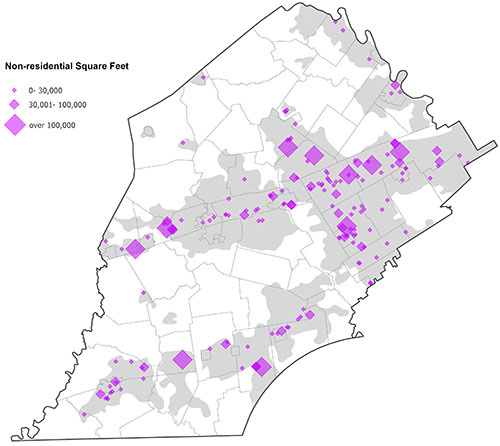
Residential Development in Growth Areas (2019-2023)

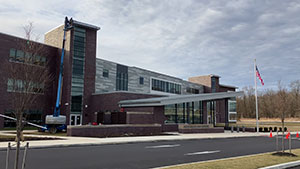
Non-residential growth in the Suburban Landscape.

Residential growth in the Suburban Center Landscape.

Mixed-use growth in the Rural Center Landscape.

Residential growth in the Urban Center Landscape.
Was this development smart growth, meaning did the development go to growth areas, especially urban and suburban centers? This is a key question and one of the fundamental goals of Landscapes3. Overall, it does seem that the development was primarily smart growth. Was it all smart growth and was it all well-designed development that fits neatly into the county's existing character? The answer to these questions is clearly no. There were a number of greenfield developments, particularly in the county's rural landscapes or the edges of suburban areas, that stand out as properties that would ideally have been preserved as open space. And quite a few developments did little to preserve natural features, open space, and historic resources or to encourage walkability, community character, or mixed uses.
Despite these sprawling developments, there was also a lot of growth in appropriate locations that preserved important site features while encouraging walkability and community character. For example, the Urban Center and Suburban Center landscapes only have 7% of the county's total land area, yet 48% of the new homes and 49% of the new nonresidential development built in the county from 2019 through 2023 went into these two landscape categories.
Approximately 9% of new homes were built in the Rural or Agricultural landscapes, which is about what Landscapes3 anticipated for smart growth to occur. Most of these development were either clustered with preserved open space and protected natural features or were very low density. From 2005 to 2015, 20% of the homes that were built went into Rural or Agricultural landscapes; so, the construction trend has improved tremendously.
On the nonresidential front, approximately 11% of the new building square footage was built in the Rural or Agricultural landscapes, with a little more acreage consumed, 526 acres, than ideal. It should be noted, however, that Landscapes3 anticipates some nonresidential development in rural and agricultural areas, particularly agricultural buildings and low intensity institutional development.
Generally, the new development built between from 2019 through 2023 has followed broad smart growth parameters.


